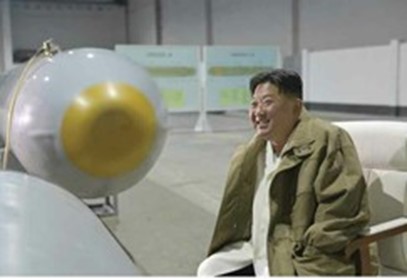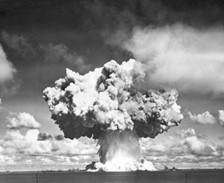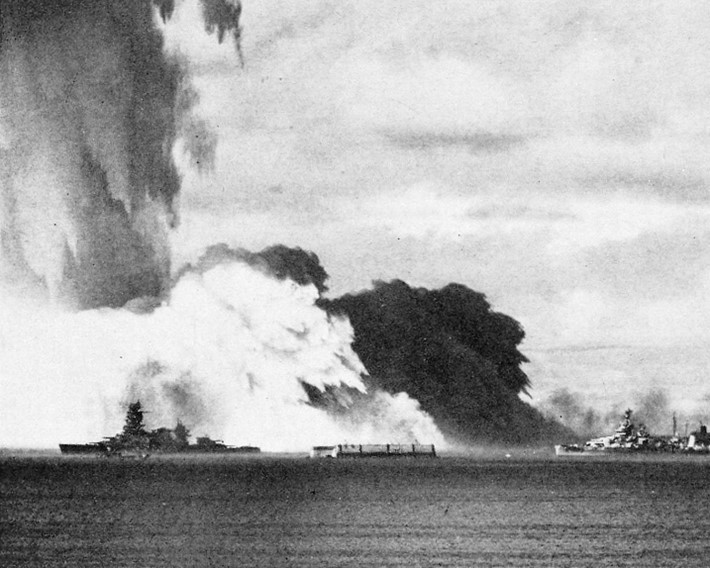Reports
Underwater Nuclear Drone: North Korea’s Nuclear Madmen
by David Albright
March 27, 2023
One remarkably irresponsible claim by Kim Jong Un is North Korea’s announced testing of an underwater drone that it states can carry a nuclear weapon, able to infiltrate enemy waters and create a deadly radioactive plume of water. 1 Kim’s parallel claims of the weapon creating a deadly tsunami can be seen as hyperbole; perhaps he is confusing a tsunami with the radioactive waterfall following the lifting of immense amounts of water into the atmosphere by an underwater nuclear explosion. Nonetheless, such a detonation could severely contaminate ships and port cities with intense radioactive fallout mixed with water.

Figure 1. Kim Jong Un beaming next to an alleged underwater drone. North Korea claims this drone can hold a nuclear weapon. Source: Rodong Sinmun.
Of course, North Korea’s ability to put a nuclear warhead into an underwater drone should not be taken as given; the announced test involved conventional explosives only. The warhead diameter can be roughly estimated by scaling from the head of a gleeful Kim next to an alleged underwater drone (Figure 1). This process gives an estimated diameter for the drone system in the range of 40 to 50 centimeters. This diameter could conceivably hold a pure fission weapon, but it is on the small size and would likely have a yield in the range of 10-25 kilotons. For comparison, Iran’s best known nuclear weapon design had a diameter of 55 centimeters and an expected yield of ten kilotons. Given North Korea’s underground testing experience, their weaponeers may be able to achieve the necessary level of miniaturization for outfitting an underwater drone with a nuclear weapon, but just as likely, North Korea cannot do so without additional underground nuclear testing aimed at reducing the diameter of the nuclear warhead while maintaining its explosive yield.
Operation Crossroads
It is worth reviewing the first underwater nuclear detonation, an unexpected radioactive disaster that occurred during Operation Crossroads in 1946. Crossroads was planned to involve three successive nuclear explosions over or under the Bikini Lagoon in the South Pacific and a host of warships placed around the lagoon as “target” vessels. The second test, codenamed Baker, was a 21 kiloton fission explosion detonated 90 feet underwater. Baker caused a huge surge of radioactively contaminated water to fall out in the test area, causing far more radioactive contamination than expected (see Figures 2 and 3). The U.S. planners had expected that the radioactive column would rise over 10,000 feet, but instead the explosion sent up a million-ton column of radioactively contaminated water, spray, and steam only about 6,000 feet into the atmosphere, entrapping more radiation near the earth’s surface, much of which rained down on the lagoon in a spectacular waterfall. The unexpected contamination led to the cancellation of the third test, and the ultimate scuttling of many of the over seventy target naval vessels moored in the vicinity of the blast point, because, despite extensive efforts by military personnel, the ships defied decontamination. 2
Many military personnel had been ordered to return to the lagoon area soon after the blast to decontaminate the target vessels. They were exposed to dangerous levels of radiation, with little protection, little training, and little hope of avoiding significant radiation doses. U.S. military leadership downplayed the extent of the radiation danger to its own troops. It was not until the mid-1980s that a new U.S. leadership, largely based in Congress, would accept the inherent risk and harm of this test. Meanwhile, U.S. leadership had come to realize the danger of such testing; the Limited Test Ban Treaty of 1963, in addition to banning atmospheric nuclear testing, also banned underwater nuclear testing.

Figure 2. Shortly after the underwater Baker test during Operation Crossroads. Source U.S. government, reproduced in Wikimedia, https://commons.wikimedia.org/wiki/File:Operation_Crossroads_Baker_(wide).jpg.


Figure 3. As the after-effects of explosion progressed, well over a million tonnes of water spray fell back into the lagoon (left image). On the right, a closeup of the radioactive base surge, like mist and water at the bottom of a waterfall, is seen moving toward the ships in the lagoon. Source U.S. government, reproduced in Wikimedia, href=”https://commons.wikimedia.org/wiki/File:Operation_Crossroads_Baker.jpg “>https://commons.wikimedia.org/wiki/File:Operation_Crossroads_Baker.jpg.
Overzealous Race for Nuclear Arms
North Korea appears oblivious of the lessons of the Cold War, as it races to develop ICBMs, SLBMs, cruise missiles, many types of tactical rockets and missiles, and now underwater drones, all slated to carry nuclear weapons. Although North Korea faces many difficulties in achieving its goals, its leadership appears stuck in the old 1950s Cold War mindset, developing far too many nuclear weapons, constantly threatening to use them, and preparing itself to fight a nuclear war, a war that in reality it can neither win nor survive.
North Korea’s announcement about a nuclear-armed drone, a weapon that the Baker test showed to have insidious radioactive fallout effects, adds further credence to its leadership’s dangerous mindset. U.S. military planners during the early Cold War had a similarly stark outlook and expected a nuclear war to break out by the 1960s. Fortunately, that war never occurred, but the close calls were numerous. North Korean leadership appears to be replaying a portion of that dangerous history. Can we avoid nuclear catastrophe again?
Kim and his closest advisors often appear gleeful about nuclear weapons or missile advancements, but from the outside they appear like drunks stumbling down an extremely perilous path. Negotiating traditional nuclear arms control limits with this group is not going to reduce the risk of nuclear war. Neither is South Korea building nuclear weapons.
The only sensible strategy is working for complete and verifiable denuclearization and refusing to give North Korea its most cherished international goal—U.S. and world acknowledgement as a nuclear power. While awaiting meaningful negotiations toward denuclearization, it is crucial for the international community to increase North Korea’s isolation and the effectiveness of sanctions, while the United States, South Korea, and Japan strengthen their alliance and military capabilities and stand ready to respond to North Korea’s nuclear threats. Kim must understand that any use of nuclear weapons against the United States or its Allies and partners, and further, any invasion into South Korea, will only lead to the end of his regime. Otherwise, we are left at the mercy of nuclear daredevils hell-bent on repeating the worst excesses of the early decades of the Cold War, including maintaining the delusion that a nuclear war can be fought and won.
1. See for example, Brad Lendon and Yoonjun Seo, “North Korea Claims to Have Tested a Nuclear-Capable Underwater Drone. Analysts Are Skeptical,” CNN, March 24, 2023. See also Rondong Sinmun, http://www.rodong.rep.kp/en/index.php?MTVAMjAyMy0wMy0yNC1IMDA0QA==. ↩
2. Arjun Makhijani and David Albright, “Irradiation of Personnel During Operation Crossroads A Evaluation Based On Official Documents,” Institute for Energy and Environmental Research, May 1983, https://ieer.org/resource/nuclear-weapons/irradiation-personnel-operation-crossroads/. ↩

 twitter
twitter